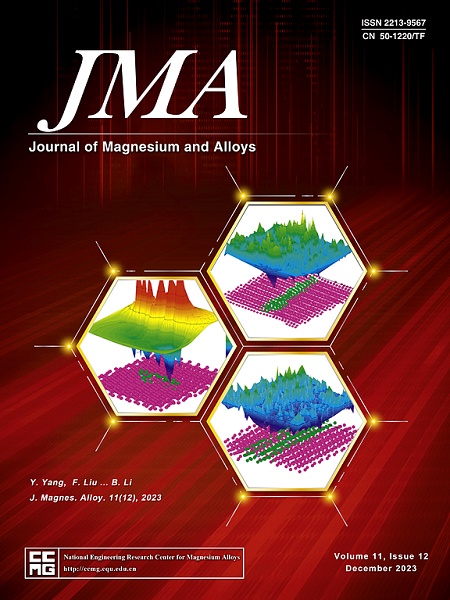Formation mechanism of W phase and its effects on the mechanical properties of Mg−Dy−Zn alloys
IF 15.8
1区 材料科学
Q1 METALLURGY & METALLURGICAL ENGINEERING
引用次数: 0
Abstract
The morphology and dimension of W phases play an important role in determining mechanical properties of Mg−RE−Zn (where RE denotes rare earth elements) alloys. In this study, the γ′ platelet and W particle occurred in the aged Mg−2Dy–0.5Zn (at.%) alloys were investigated by aberration-corrected scanning transmission electron microscopy. A novel formation mechanism of W phase was proposed, and its effects on the morphology and dimension of W particle, as well as mechanical properties of Mg−2Dy–0.5Zn alloys, were also discussed particularly. Different from other Mg−RE−Zn alloys, the nucleation and growth of W particle in Mg−Dy–Zn alloys mainly depend on the precipitated γ′ platelet. Primarily, a mass of Dy and Zn solute atoms concentrated near γ′ platelet or between two adjacent γ′ platelets can meet the composition requirement of W particle nucleation. Next, the smaller interfacial mismatch between W and γ′ facilitates the nucleation and growth of W particle. Thirdly, the growth of W particle can be achieved by consuming the surrounding γ′ platelets. The nucleation and growth mechanisms make W particles exhibit rectangular or leaf-like and remain at the nanoscale. The coexistence of γ′ platelets and nanoscale W particles, and some better interfacial relationships between phases, lead to a high strength-ductility synergy of alloy. The findings may provide some fundamental guidelines for the microstructure design and optimization of new-type Mg-based alloys.

W 相的形成机理及其对 Mg-Dy-Zn 合金机械性能的影响
W相的形貌和尺寸对Mg - RE - Zn (RE为稀土元素)合金的力学性能有重要影响。采用像差校正扫描透射电镜研究了时效Mg−2Dy-0.5Zn (at.%)合金中γ′血小板和W粒子的分布。提出了一种新的W相形成机理,重点讨论了W相形成对Mg−2Dy-0.5Zn合金形貌、尺寸及力学性能的影响。与其他Mg−RE−Zn合金不同,Mg−Dy-Zn合金中W粒子的形核和长大主要依赖于析出的γ′血小板。首先,大量的Dy和Zn溶质原子集中在γ′血小板附近或两个相邻的γ′血小板之间,可以满足W粒子成核的组成要求。其次,W与γ′之间较小的界面失配有利于W粒子的成核和生长。第三,W粒子的生长可以通过消耗周围的γ′血小板来实现。W粒子的成核和生长机制使其呈矩形或叶状,并保持在纳米尺度上。γ′血小板和纳米W颗粒的共存,以及相间良好的界面关系,使合金具有较高的强度-塑性协同效应。研究结果可为新型镁基合金的组织设计和优化提供一些基本指导。
本文章由计算机程序翻译,如有差异,请以英文原文为准。
求助全文
约1分钟内获得全文
求助全文
来源期刊

Journal of Magnesium and Alloys
Engineering-Mechanics of Materials
CiteScore
20.20
自引率
14.80%
发文量
52
审稿时长
59 days
期刊介绍:
The Journal of Magnesium and Alloys serves as a global platform for both theoretical and experimental studies in magnesium science and engineering. It welcomes submissions investigating various scientific and engineering factors impacting the metallurgy, processing, microstructure, properties, and applications of magnesium and alloys. The journal covers all aspects of magnesium and alloy research, including raw materials, alloy casting, extrusion and deformation, corrosion and surface treatment, joining and machining, simulation and modeling, microstructure evolution and mechanical properties, new alloy development, magnesium-based composites, bio-materials and energy materials, applications, and recycling.
 求助内容:
求助内容: 应助结果提醒方式:
应助结果提醒方式:


